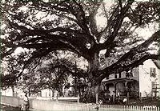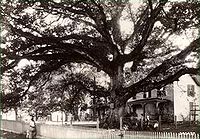
Wye Oak
Encyclopedia

Maryland
Maryland is a U.S. state located in the Mid Atlantic region of the United States, bordering Virginia, West Virginia, and the District of Columbia to its south and west; Pennsylvania to its north; and Delaware to its east...
, and the largest white oak
White oak
Quercus alba, the white oak, is one of the pre-eminent hardwoods of eastern North America. It is a long-lived oak of the Fagaceae family, native to eastern North America and found from southern Quebec west to eastern Minnesota and south to northern Florida and eastern Texas. Specimens have been...
tree in the United States
United States
The United States of America is a federal constitutional republic comprising fifty states and a federal district...
. Located in the town of Wye Mills, Talbot County, Maryland
Talbot County, Maryland
-2010:Whereas according to the 2010 U.S. Census Bureau:*81.4% White*12.8% Black*0.2% Native American*1.2% Asian*0.1% Native Hawaiian or Pacific Islander*1.6% Two or more races*2.7% Other races*5.5% Hispanic or Latino -2000:...
, the Wye Oak was believed to be over 460 years old at the time of its destruction during a severe thunderstorm on June 6, 2002, and measured 31 feet 10 inches (970 cm) in circumference of the trunk at diameter at breast height
Diameter at breast height
Diameter at breast height, or DBH, is a standard method of expressing the diameter of the trunk or bole of a standing tree. DBH is one of the most common dendrometric measurements....
, 96 feet (29 m) high, with a crown spread of 119 feet (36 m). It is believed that the acorn that became the oak germinated around the year 1540.
The Wye Oak first drew the attention of the public in 1909, when Fred W. Besley, the first Maryland State Forester, made the first official measurement of the tree. Ten years later, in 1919, it was featured in American Forester magazine. In 1939, the Maryland General Assembly
Maryland General Assembly
The Maryland General Assembly is the state legislature of the U.S. state of Maryland. It is a bicameral body. The upper chamber, the Maryland State Senate, has 47 representatives and the lower chamber, the Maryland House of Delegates, has 141 representatives...
purchased the tree and almost 30 acres (121,000 m²) surrounding it and established the Wye Oak State Park. The Wye Oak inspired Besley to found the Big Tree Champion Program in 1925; as a result, in 1940 the American Forestry Association
American Forestry Association
The American Forestry Association was formed in Chicago, Illinois in September 1875 by John Aston Warder. The current headquarters are in Washington, D.C.. The organization acts as a clearinghouse for environmental organizations working to preserve world tree growth. The "National Register of...
named the Wye Oak one of its first National Champion Trees
National Register of Big Trees
The National Register of Big Trees is a list of the largest living specimens of each tree variety found in the continental United States. A tree on this list is often called a National Champion Tree....
. By the time of its destruction 62 years later, only one other tree named that year remained standing.
Dr. Frank Gouin, Professor Emeritus of Horticulture at the University of Maryland, College Park
University of Maryland, College Park
The University of Maryland, College Park is a top-ranked public research university located in the city of College Park in Prince George's County, Maryland, just outside Washington, D.C...
, impressed both by the age and size of the tree, as well as its unusual resistance to oak wilt fungus
Oak wilt
Oak wilt is a fungal disease that can quickly kill an oak tree. It is caused by the fungus Ceratocystis fagacearum. Symptoms vary by tree species but generally consist of leaf discoloration, wilt, defoliation, and death. The fungus is spread from diseased to healthy trees by insect vectors or via...
and the gypsy moth
Gypsy moth
The gypsy moth, Lymantria dispar, is a moth in the family Lymantriidae of Eurasian origin. Originally ranging from Europe to Asia, it was introduced to North America in the late 1860s and has been expanding its range ever since...
, led a successful effort to clone the Wye Oak. The first two cloned saplings were planted at Mount Vernon
Mount Vernon (plantation)
Mount Vernon, located near Alexandria, Virginia, was the plantation home of the first President of the United States, George Washington. The mansion is built of wood in neoclassical Georgian architectural style, and the estate is located on the banks of the Potomac River.Mount Vernon was designated...
on April 26, 2002. Its exceptionally long life has been attributed to the efforts of park managers, who applied preventative measures such as fertilizer
Fertilizer
Fertilizer is any organic or inorganic material of natural or synthetic origin that is added to a soil to supply one or more plant nutrients essential to the growth of plants. A recent assessment found that about 40 to 60% of crop yields are attributable to commercial fertilizer use...
and insecticide
Insecticide
An insecticide is a pesticide used against insects. They include ovicides and larvicides used against the eggs and larvae of insects respectively. Insecticides are used in agriculture, medicine, industry and the household. The use of insecticides is believed to be one of the major factors behind...
, as well as extensive pruning
Pruning
Pruning is a horticultural practice involving the selective removal of parts of a plant, such as branches, buds, or roots. Reasons to prune plants include deadwood removal, shaping , improving or maintaining health, reducing risk from falling branches, preparing nursery specimens for...
, cabling
Cable
A cable is two or more wires running side by side and bonded, twisted or braided together to form a single assembly. In mechanics cables, otherwise known as wire ropes, are used for lifting, hauling and towing or conveying force through tension. In electrical engineering cables are used to carry...
, and bracing
Brace (tool)
A brace or brace and bit is a hand tool used to drill holes, usually in wood. Pressure is applied to the top and the tool is rotated with a U-shaped grip....
to the branches.
The tree fell during a heavy thunderstorm with high winds on the night of June 6, 2002.
The site of the Wye Oak remains largely untouched, and the descriptive plaque placed there in 1921 remains at the site. Next to the site of the tree, and also maintained as part Wye Oak State Park, is a one-room brick schoolhouse hailing from the colonial period. It is the second oldest schoolhouse in Talbot County.
With the demise of the Wye Oak, the Linden Oak
Linden Oak
The Linden Oak is believed to be the largest white oak tree in the United States and is 275 years old. It received this designation after the famous Wye Oak in Wye Mills, Maryland was destroyed by a windstorm in 2002....
in North Bethesda, Maryland
North Bethesda, Maryland
North Bethesda is a census-designated place and an unincorporated area in Montgomery County, Maryland, United States. It borders the city of Rockville, and is closely associated with the city.-Geography:...
, is now the largest white oak tree in the US. (It is located beside the junction of Rockville Pike
Maryland Route 355
Maryland Route 355 is a north–south road in western central Maryland in the United States. The southern terminus of the route is at the Washington, D.C. border in Friendship Heights, Montgomery County, where it continues south as Wisconsin Avenue into Washington. The northern terminus is...
and Rock Creek Park
Rock Creek Park
Rock Creek Park is a large urban natural area with public park facilities that bisects Washington, D.C. The park is administered by the National Park Service.-Rock Creek Park:The main section of the park contains , or , along the Rock Creek Valley...
's Beach Drive, and when the Washington Metro
Washington Metro
The Washington Metro, commonly called Metro, and unofficially Metrorail, is the rapid transit system in Washington, D.C., United States, and its surrounding suburbs. It is administered by the Washington Metropolitan Area Transit Authority , which also operates Metrobus service under the Metro name...
was constructed, a special curve was added to the tracks in order to protect the tree.)
Wood from the destroyed tree was used to build a new desk for the Governor's office. The wood was also used to age Heavy Seas beer.
At its creation in 1939 the park containing the Wye Oak was a little over an acre in size, according to Wye Oak, The History of a Great Tree, by Dickson J. Preston (1972, Tidewater Publishers, Cambridge, Maryland 21613, ISBN 0-87033-180-9) on p. 98: "[A]t 2:45 p.m. on September 20, 1939, just before the options were due to expire, the deeds transferring title to the State of Maryland were recorded at the Talbot County Courthouse in Easton. The Kinnamon and Straughn lots were identical in size: each had a frontage of 74½ feet and extended back from the road for a distance of 19 perches (a perch equals a rod, or 16½ feet, so that their depth was 313.5 feet). The park thus created was about an acre and a half [sic; this actually works out to just over an acre] in size -- the smallest in the state and perhaps in the nation, though not nearly as small as most people thought."

